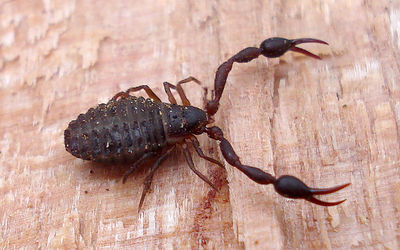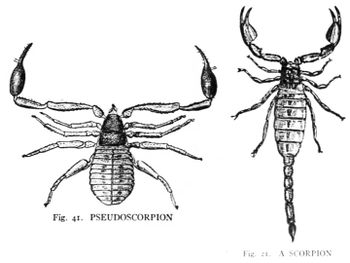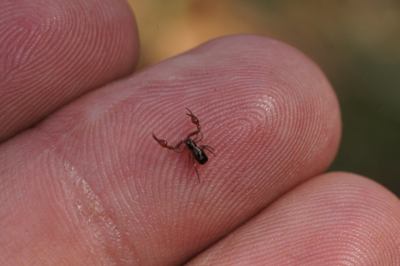Pseudoscorpions: Difference between revisions
mNo edit summary |
mNo edit summary |
||
| Line 23: | Line 23: | ||
|} | |} | ||
Pseudoscorpions, also referred to as false scorpions or book scorpions, are small arachnids with pincer-like appendages that resemble those of [[scorpions]]. These appendages, called pedipalps, function similarly to claws and are relatively large in comparison to their overall size<ref name="Jacobs"></ref>. Generally reaching lengths of about 2–8 millimeters at maturity, pseudoscorpions often go undetected or are mistaken for ticks. However, unlike ticks, pseudoscorpions are not regarded as harmful to humans. In fact, they prey upon many small | Pseudoscorpions, also referred to as false scorpions or book scorpions, are small arachnids with pincer-like appendages that resemble those of [[scorpions]]. These appendages, called pedipalps, function similarly to claws and are relatively large in comparison to their overall size<ref name="Jacobs"></ref>. Generally reaching lengths of about 2–8 millimeters at maturity, pseudoscorpions often go undetected or are mistaken for ticks. However, unlike ticks, pseudoscorpions are not regarded as harmful to humans. In fact, they prey upon many small arthropods, aiding with pest control<ref name="Lewis"> Lewis, D. (n.d.). The Benefits of Pseudoscorpions. Retrieved from https://www.extension.iastate.edu/news/2008/mar/071001.htm</ref>. | ||
== Characteristics and Morphology == | == Characteristics and Morphology == | ||
| Line 45: | Line 45: | ||
== Diet and Feeding Behaviors == | == Diet and Feeding Behaviors == | ||
Pseudoscorpions are carnivorous organisms, preying on a large range of small [[insects]], mites, and larvae. Often targeting common house pests such as booklice, clothes moths, dust mites, ants, and more, pseudoscorpions are able to survive indoors for periods of time<ref name="Missouri"></ref>. Pseudoscorpions utilize their venom glands, residing within their elongated pedipalps, to immobilize and capture their prey efficiently. They pour semi-corrosive saliva over their prey to aid in a smooth external digestion, before ingesting the liquid remains. This venom is an important mechanism to the feeding of pseudoscorpions, without being harmful to humans or pets<ref name="Lewis"></ref>. | Pseudoscorpions are carnivorous organisms, preying on a large range of small [[insects]], [[mites]], and larvae. Often targeting common house pests such as booklice, clothes moths, dust mites, ants, and more, pseudoscorpions are able to survive indoors for periods of time<ref name="Missouri"></ref>. Pseudoscorpions utilize their venom glands, residing within their elongated pedipalps, to immobilize and capture their prey efficiently. They pour semi-corrosive saliva over their prey to aid in a smooth external digestion, before ingesting the liquid remains. This venom is an important mechanism to the feeding of pseudoscorpions, without being harmful to humans or pets<ref name="Lewis"></ref>. | ||
== Distribution == | == Distribution == | ||
There are over 3,300 identified species of pseudoscorpions. These small arachnids are found worldwide, ranging from the tropical regions of the globe- which is where the most dense and diverse populations are found- to the temperate cold regions. Pseudoscorpions have spread to island territories as well, with endemic species being recorded within the Canary Islands and the Maltese Islands. | There are over 3,300 identified species of pseudoscorpions. These small arachnids are found worldwide, ranging from the tropical regions of the globe- which is where the most dense and diverse populations are found- to the temperate cold regions. Pseudoscorpions have spread to island territories as well, with endemic species being recorded within the Canary Islands and the Maltese Islands. | ||
Across these regions, these [[organisms]] can be located dwelling in many different types of habitats and environments<ref name="Comstock"></ref>. Species are found under tree bark and within tree hollows, beneath the [[soil]] surface, under leaf litter, under stones and within rock fractures, inside caves, on ocean shores, and within buildings and homes. Indoors, pseudoscorpions are commonly observed in rooms containing many books. Thus, explaining their alternate name of book scorpions, they feed upon the booklice and dust | Across these regions, these [[organisms]] can be located dwelling in many different types of habitats and environments<ref name="Comstock"></ref>. Species are found under tree bark and within tree hollows, beneath the [[soil]] surface, under leaf litter, under stones and within rock fractures, inside caves, on ocean shores, and within buildings and homes. Indoors, pseudoscorpions are commonly observed in rooms containing many books. Thus, explaining their alternate name of book scorpions, they feed upon the booklice and dust mites that often reside within bookshelves<ref name="Missouri"></ref>. | ||
Revision as of 17:45, 6 March 2025
 | |
| Kingdom: | Animalia |
|---|---|
| Phylum: | Arthropoda |
| Subphylum: | Chelicerata |
| Class: | Arachnida |
| Order: | Pseudoscorpiones |
| Source: | |
Pseudoscorpions, also referred to as false scorpions or book scorpions, are small arachnids with pincer-like appendages that resemble those of scorpions. These appendages, called pedipalps, function similarly to claws and are relatively large in comparison to their overall size[1]. Generally reaching lengths of about 2–8 millimeters at maturity, pseudoscorpions often go undetected or are mistaken for ticks. However, unlike ticks, pseudoscorpions are not regarded as harmful to humans. In fact, they prey upon many small arthropods, aiding with pest control[2].
Characteristics and Morphology

Pseudoscorpions superficially resemble true scorpions; however, they lack an elongated metasoma (tail) and stinger at the end of their abdomens[4]. Another crucial difference between the two types of arachnids is size. A common house pseudoscorpion, such as the Chelifer cancroides, will usually only grow between 2.5–4.5 millimeters (0.10–0.18 in). Overall, species of pseudoscorpions have an average size of 3mm (0.1 in), much smaller than the average scorpion[5].
Species of pseudoscorpions have flat, teardrop shaped bodies with rounded ends. The lower abdomen of a pseudoscorpion, also called the opisthosoma, is composed of 12 segmented sections. These segments are protected by plates made of chitin. Located on the sides of its cephalothorax (head and thorax), a pseudoscorpion may have 1–2 pairs of eyes, or no eyes at all[1].
As members of the Arachnida class, these small organisms have 8 legs. Pseudoscorpions shuffle their legs similar to crabs, allowing them to walk as quickly backwards as they do forwards[6].
Most pseudoscorpions have abdomens that are yellowish to brown mahogany, though the pedipalps often contrast in color. These pedipalps grow over twice the length of their legs, measuring 7–9mm across when fully extended[1]. Pedipalps consist of an immobile hand and a finger. Separate moveable fingers are controlled by adductor muscles. A venom gland and venom duct are usually located in the mobile finger. Additionally, pseudoscorpions possess a gland located within in the jaw for the purpose of producing silk. Pseudoscorpions use this silk to make cocoons for mating, molting, or enduring cold weather[5].

Reproduction and Life Cycle
Male pseudoscorpions produce sperm, which is usually planted or laid upon surfaces for the females to take into their bodies. It has been observed that the males will often produce and deposit of their sperm without necessarily being in the presence of a female. Certain pseudoscorpion species will also perform mating dances to actively call females to an area after depositing a spermatophore, assisting the female over the location to fertilize her eggs[4]. Though, males of other pseudoscorpion species may directly transfer the sperm into the female with the use of their pedipalp claws.
The eggs mature internally within a female's brood pouch, connected to the abdomen. In a single brood, a cluster of 20-50 young can be hatched. The young remain attached to the mother's body for safety for a brief time afterwards[1]. Most pseudoscorpion species have a lifespan of several years, which is spent going through 3 molting stages before reaching maturity. Pseudoscorpions spend an average of 2-3 years as mature adults[7].
Diet and Feeding Behaviors
Pseudoscorpions are carnivorous organisms, preying on a large range of small insects, mites, and larvae. Often targeting common house pests such as booklice, clothes moths, dust mites, ants, and more, pseudoscorpions are able to survive indoors for periods of time[7]. Pseudoscorpions utilize their venom glands, residing within their elongated pedipalps, to immobilize and capture their prey efficiently. They pour semi-corrosive saliva over their prey to aid in a smooth external digestion, before ingesting the liquid remains. This venom is an important mechanism to the feeding of pseudoscorpions, without being harmful to humans or pets[2].
Distribution
There are over 3,300 identified species of pseudoscorpions. These small arachnids are found worldwide, ranging from the tropical regions of the globe- which is where the most dense and diverse populations are found- to the temperate cold regions. Pseudoscorpions have spread to island territories as well, with endemic species being recorded within the Canary Islands and the Maltese Islands. Across these regions, these organisms can be located dwelling in many different types of habitats and environments[3]. Species are found under tree bark and within tree hollows, beneath the soil surface, under leaf litter, under stones and within rock fractures, inside caves, on ocean shores, and within buildings and homes. Indoors, pseudoscorpions are commonly observed in rooms containing many books. Thus, explaining their alternate name of book scorpions, they feed upon the booklice and dust mites that often reside within bookshelves[7].
References
- ↑ 1.0 1.1 1.2 1.3 1.4 Jacobs Sr., S, (2013). Pseudoscorpions (Department of Entomology). Retrieved from http://ento.psu.edu/extension/factsheets/pseudoscorpions
- ↑ 2.0 2.1 Lewis, D. (n.d.). The Benefits of Pseudoscorpions. Retrieved from https://www.extension.iastate.edu/news/2008/mar/071001.htm
- ↑ 3.0 3.1 Comstock, J. H., & Gertsch, W. J. (1980). The spider book: A manual for the study of the spiders and their near relatives, the scorpions, pseudoscorpions, whip-scorpions, harvestmen, and other members of the class arachnida, found in America North of Mexico, with analytical keys for their classification and popular accounts of their habits. Ithaca: Comstock.
- ↑ 4.0 4.1 Government of Western Australia. (n.d.). What are pseudoscorpions? Retrieved from http://www.museum.wa.gov.au/catalogues/pseudoscorpions/what-are-pseudoscorpions
- ↑ 5.0 5.1 All About Pseudoscorpions - The Predatory False Scorpion. (n.d.) Retrieved from https://www.chaosofdelight.org/pseudoscorpions
- ↑ 6.0 6.1 Hahn, J., & Kells, S. (2018). Pseudoscorpions. Retrieved from https://extension.umn.edu/insect-relatives/pseudoscorpions
- ↑ 7.0 7.1 7.2 Missouri Department of Conservation: Pseudoscorpions. (n.d) Retrieved from https://mdc.mo.gov/discover-nature/field-guide/pseudoscorpions